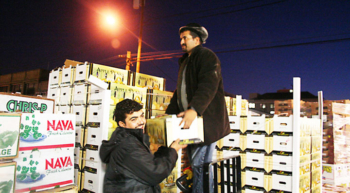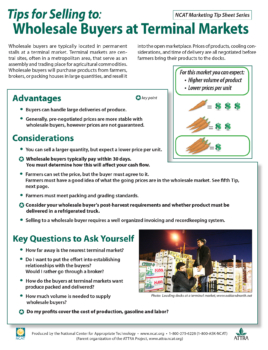Tips for Selling to Wholesale Buyers at Terminal Markets
NCAT Marketing Tipsheet Series
By Marisa Alcorta, Rex Dufour, and Tammy Hinman, NCAT

Loading docks at a terminal market. Photo: oaklandnorth.net
Wholesale buyers are typically located in permanent stalls at a terminal market. Terminal markets are central sites, often in a metropolitan area, that serve as an assembly and trading place for agricultural commodities. Wholesale buyers will purchase products from farmers, brokers, or packing houses in large quantities, and resell it into the open marketplace. Prices of products, cooling considerations, and time of delivery are all negotiated before farmers bring their products to the docks.
For this market you can expect:
- Higher volume of product
- Lower prices per unit
Advantages
- Buyers can handle large deliveries of produce.
- Generally, pre-negotiated prices are more stable with wholesale buyers, however prices are not guaranteed.
Considerations
- You can sell a larger quantity, but expect a lower price per unit.
- Wholesale buyers typically pay within 30 days. You must determine how this will affect your cash flow.
- Farmers can set the price, but the buyer must agree to it. Farmers must have a good idea of what the going prices are in the wholesale market.
- Farmers must meet packing and grading standards.
- Consider your wholesale buyer’s post-harvest requirements and whether product must be delivered in a refrigerated truck.
- Selling to a wholesale buyer requires a well organized invoicing and recordkeeping system.
Key Questions to Ask Yourself
- How far away is the nearest terminal market?
- Do I want to put the effort into establishing relationships with the buyers? Would I rather go through a broker?
- How do the buyers at terminal markets want produce packed and delivered?
- How much volume is needed to supply wholesale buyers?
- Do my profits cover the cost of production, gasoline and labor?
Tips for Selling to Wholesale Buyers at Terminal Markets
Visit a terminal market to get an idea of how it works and learn about the competition. To talk to a wholesale buyer and show them your produce, visit after 6 or 7 a.m. To see the market operating at busy times, visit around 3 or 4 a.m.
- Terminal markets are typically open from 11 p.m. to 12 noon. To sell a product, farmers must deliver to the terminal market late at night or very early in the morning. Most deliveries take place between 11 p.m. and 4 a.m. Buyers begin arriving at 5 a.m. to purchase products.
- Identify and contact wholesale buyers before you try to sell to them. Farmers can get higher prices through established relationships, for higher quality products, and for unique or specialty products in high demand.
- If this will be a regular market channel, plan to bring them product on a regular basis. Consistency and quality are keys to success in this market.
- Check the USDA Terminal Market Reports for prices on your product before you try to negotiate with a wholesale buyer.
- Ensure high quality by using good pre-cooling and post-harvest practices.
- Don’t use this channel if you have less than 50 to 100 boxes of each item. Wholesale buyers only purchase large quantities.
Resources
The Packer is a weekly newspaper covering fruit and vegetable news, produce shipping, distribution, packing, marketing, and trends in fresh produce in North America.
Wholesale Success: A Farmers Guide to Selling, Post Harvest Handling, and Packing Produce is a 255-page manual about the wholesale produce industry, with details on building relationships, food safety, grading standards, filling orders, record keeping, and billing. The manual includes harvesting, cooling, storing, and packing information for 103 different fruits and vegetables.
AMS Fresh Fruit, Vegetable, Nut, and Specialty Crop Grade Standards lists the U.S. Agricultural Marketing Service grade (quality) standards for each fruit, vegetable and nut sold as commodities.
Community Food Security Liability & Food Safety (in English and Spanish). This short brochure summarizes some of the issues regarding food safety when selling to institutional markets. It gives the reader information on what to expect for insurance requirements and how to better protect your farm.
USDA Terminal Market Report lists current wholesale prices.
Rodale Institute Organic Price Report can be configured to show organic only or to compare organic and conventional wholesale prices at the current market rates. Prices of fruit, vegetables and grains are listed for six different wholesale terminals across the U.S.
UC Davis Small Farm Program Wholesale Market Resources explain wholesale buyers and terminal markets.
Tips for Selling to Wholesale Buyers at Terminal Markets
© 2012 National Center for Appropriate Technology—NCAT
By Marisa Alcorta, Rex Dufour, and Tammy Hinman, NCAT
IP 432
This publication is produced by the National Center for Appropriate Technology through the ATTRA Sustainable Agriculture program, under a cooperative agreement with USDA Rural Development. This publication was also made possible in part by funding from USDA/NIFA/OASDFR. ATTRA.NCAT.ORG.


